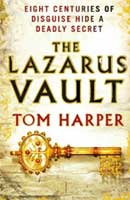Tom Harper was born in West Germany and grew up in Germany, Belgium and America. He studied history at Lincoln College, Oxford, worked for a while in the glamorous world of pensions services, and now writes full time. At last count, his novels have been sold into twenty languages, from Brazil to China.
 |
Bankers, eh?
They’re a punchline for comedians and a punchbag for politicians, but they do have other uses. For one, they make excellent villains.
My new novel, The Lazarus Vault, centres around the small, reclusive and fabulously wealthy Monsalvat Bank in the City of London. A young trainee, Ellie Stanton, is recruited to work there and quickly seduced by the privileged world they offer. But soon she finds out that the bank’s vault harbours a deadly treasure that reaches back to the middle ages, and the greatest quest in history.
Most of my novels deal, one way or another, with the constant dialogue between past and present. When I was writing about the crusades, the parallels with present-day armies invading the Middle East were implicit but inescapable. More recently, I’ve been writing thrillers where historical and modern-day stories are woven together. The challenge with this sort of book is finding a credible villain – an organisation or institution that has survived more or less unchanged for centuries. That’s why, in conspiracy thrillers like Dan Brown’s, the Catholic church makes such a convenient baddie. Ditto secret societies: the Freemasons, Illuminati, Rosicrucians etc.
To that list, you can add banks. They’ve got deep historical roots: the oldest bank in Europe, Monte deiPaschi di Siena, dates from 1472. They’re often family-run, hugely rich and incredibly secretive. They wield immense power. In short, the perfect organisations for hoarding secrets across the centuries.
Obviously, the idea of a villainous banker isn’t much of a stretch these days. But what interested me for the book wasn’t the extravagant bonuses or toxic assets that get the press these days: it was the historical parallels. The historical element of The Lazarus Vault centres on the rough feudalism of the mid-twelfth century, a period when kings were just starting to reign in the worst excesses of their magnates, who until then had enjoyed pretty much complete freedom to rape, pillage, extort, and pursue small wars on their own account. I was fascinated by the historical echoes between twenty-first century capitalism and twelfth-century feudalisms. Even the vocabulary is the same: the financial pages are full of robber barons, white knights, corporate raiders and takeover battles. In both cases, you have a wealthy, close-knit international elite living in a remote world, high off the back of assets they never actually touch. In the twelfth century, those assets were land; now, they’re companies. In both cases, the poor serfs who actually make the assets productive don’t get much of a look-in. In both cases, when assets change hands – often forcibly – they’re the ones who suffer. In the middle ages, lords had nicknames like ‘Land-Waster’ or ‘Butcher’. Nowadays, you get ‘Neutron Jack’ Welch, famous for sacking 100,000 employees. A lot of this is metaphorical, but when I saw riot police carrying shields and batons, wearing helmets and body-armour, attacking (and in one case, it appeared, killing) protestors at the G20 summit in London, I wasn’t so sure. Some of the police were even on horseback. Strip away the high-visibility vests, and you could have been looking straight onto a twelfth century battlefield.
(Interestingly, a letter published in The Economist newspaper while I was writing The Lazarus Vault (http://www.economist.com/node/14793047) also picked up on the parallels. The correspondent wrote: ‘Corporations are organised and run in the same hierarchical, non-democratic manner that feudal societies were. The lord provides protection and defence so the workers can produce without fear of raiders taking their life’s bread. In exchange, the lord gets a percentage of the production. One could argue that we still live in feudal societies as the dominant organisation in most people’s lives is the company they work for.’)
There was another thing that attracted me to writing about the City of London: the City of London itself. History isn’t a series of discrete, hierarchical levels, neatly divided like the chapters of a textbook or the modules of an exam syllabus. It’s a mess. Some things pass quickly, others endure. The City of London seems to render that historical process in brick and concrete. Thirteenth century guildhalls sit in the shadow of twenty-first century statements like the Gherkin; the ultra-modern Lloyds building houses an organisation that began in a seventeenth-century coffee shop, and stands next to Leadenhall Market, a nineteenth century iteration of a market that’s been there since the middle ages. The Barbican, a proud statement of twentieth-century modernism, has holes cut in it so you can see the Roman walls underneath. And we pass in and out of these buildings, using them as our own, accepting them all as part of our world. Not ‘living history’ like you find at Hampton Court or Colonial Williamsburg, actors in costumes, but history so alive we barely notice it.
So is this novel an earnest critique of modern capitalism? An indictment of a failing economic model? In a word, no. It’s an adventure story and a thriller. It reaches back to the middle ages to grab the elements that have always made the best stories – a damsel in distress, an age-old quest and a long-lost treasure locked in a vault – and relocates them to the epicentre of the modern world. A place where the Hobbesian struggle of all against all is alive and well. A place where money is power, and the powerful live in fortified towers with armed men to hold back the mob. A place where good men wring their hands and bad men fill their pockets, and danger threatens on every side.
As William Faulkner said: ‘The past is never dead. It’s not even past.’You can read the draft of the first chapter of THE LAZRUS VAULTS here.

Arrow Books
RRP: £6.99
30/09/10
